Below the brine and all is fine.
Below the brine – with lots of room for brine expansion – and all is superfine.
Below the brine – when your sauerkraut is stored in the refrigerator – and all is stupendous.
Is it really possible???
When I first saw the ViscoDisc™ Canning Buddies, I was excited to run them through my fermentation tests to see how well they worked for not only sauerkraut, but also for loose vegetables – that like to float to the surface, and pastes – that need quite a bit of force to hold below the brine.
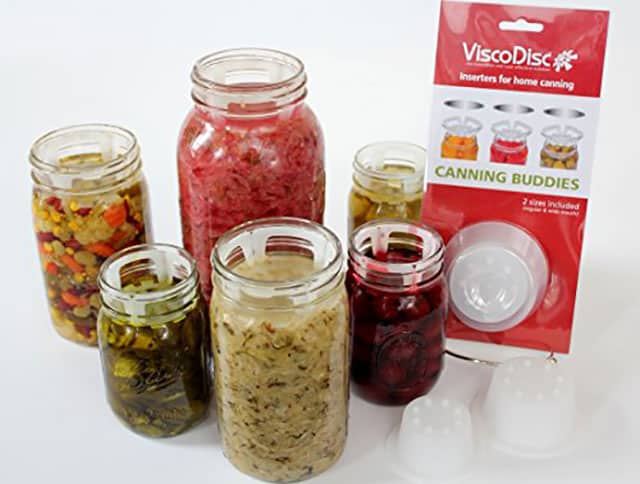
I was attracted to the ViscoDisc Canning Buddies for a few reasons.
- Small profile.
- Sized for both regular-mouth and wide-mouth jars.
- A package containing one dozen can be purchased for just under $15.
- And though I really hate to use plastic, lab tastes verified: “There has been no leaching of harmful chemicals into the product (fermenting in the jar).”
Good for starters, but would it solve my latest fermentation challenge?
Which is actually a…
Three-Fold Fermentation Challenge
Challenge number one…
1. Below the Brine and All is Fine.
There are endless ways to hold your ferment below the brine, some working better than others. Before the surge in the popularity of fermentation – and ensuing products, my preferred method has been a small jar.
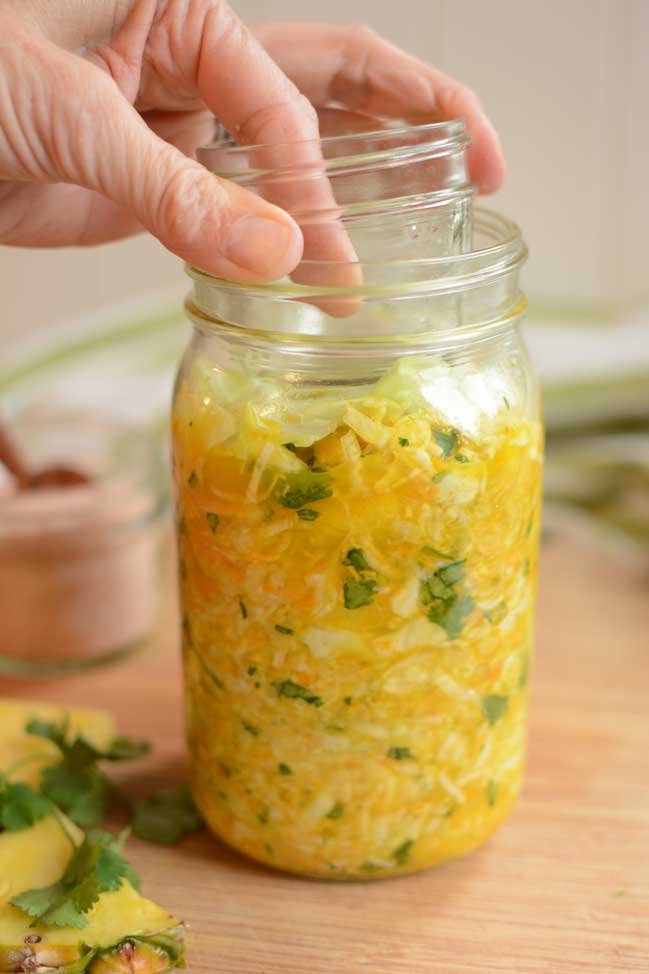
This works for me because it is:
- Food safe.
- Readily available… at least in North America.
- Affordable.
The next fermentation challenge…
2. Below the Brine – with Lots of Room for Brine Expansion – and All is Superfine
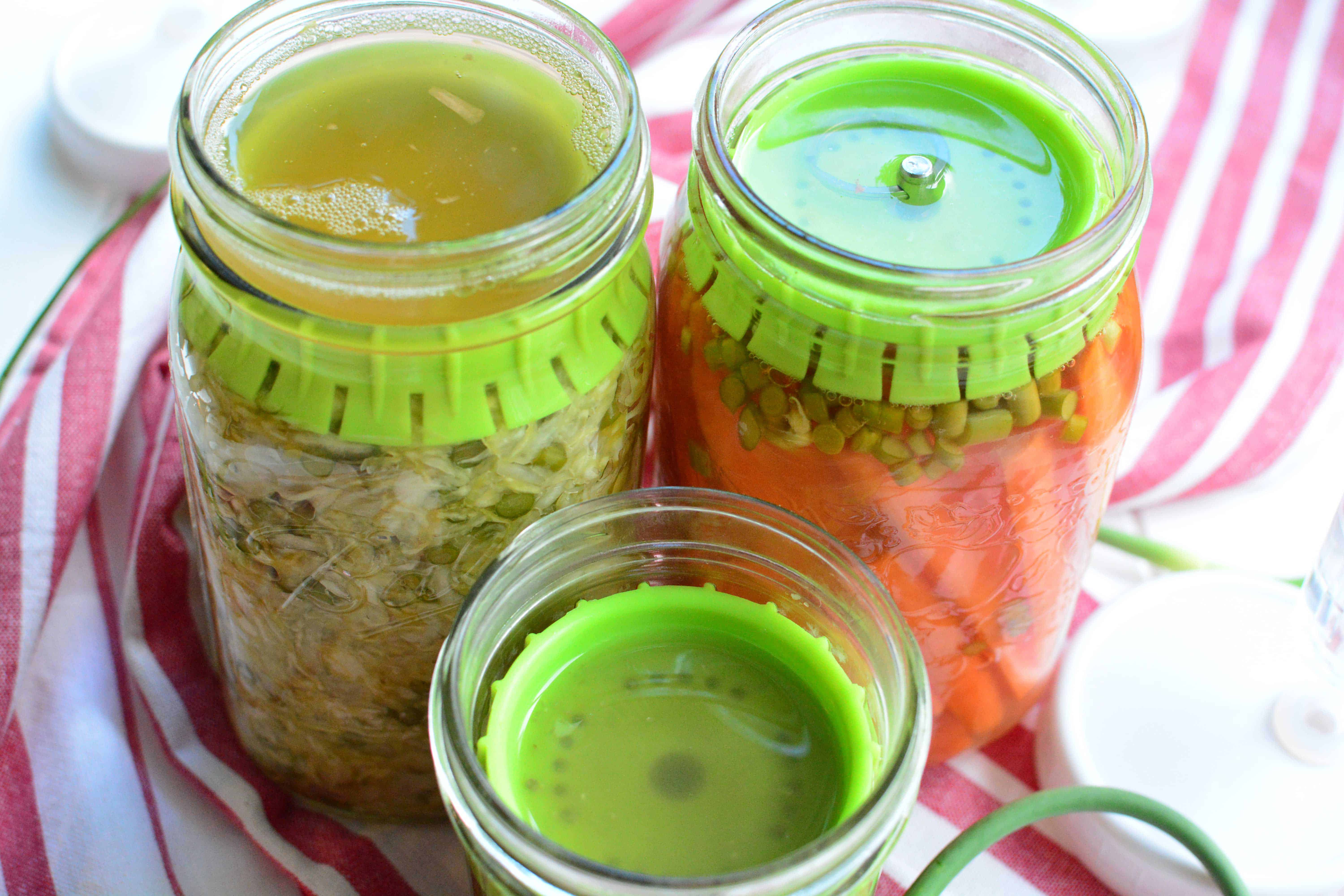
The major drawback of a small jar is the loss of brine at the beginning stages of fermentation. It takes up space that would be better used for brine, Solution…
Drill a hole in the bottom of my little jar so there is a place for brine to expand into. Now, who has the tools or time for that?
Or, purchase a fermentation tool designed for this purpose. Here are a few I have reviewed:
Pickle-Pushing No-Float Jar-Packer Review: Ingenious
Pickle Pipe Pickle Pebble [MasonTops] REVIEW: Delightfully Simple
These are not too bad on the pocketbook if you need just a few. After all, my focus is on keeping fermentation affordable and recommending that your money is best spent on a water-sealed fermentation crock for out-of-this-world sauerkraut.
However, I’ve been looking for something that I can use with all the jars I put up each Fall and store for the ensuing year. The ones fermented in a water-sealed crock, tend to have plenty of brine. It’s with the ones fermented in a jar that there is the problem. In 2015, I ended up with 44 jars, half of which were fermented directly in the jar.
Enter fermentation challenge number…
3. Below the brine – When Your Sauerkraut is Stored in the Refrigerator – and All is Stupendous
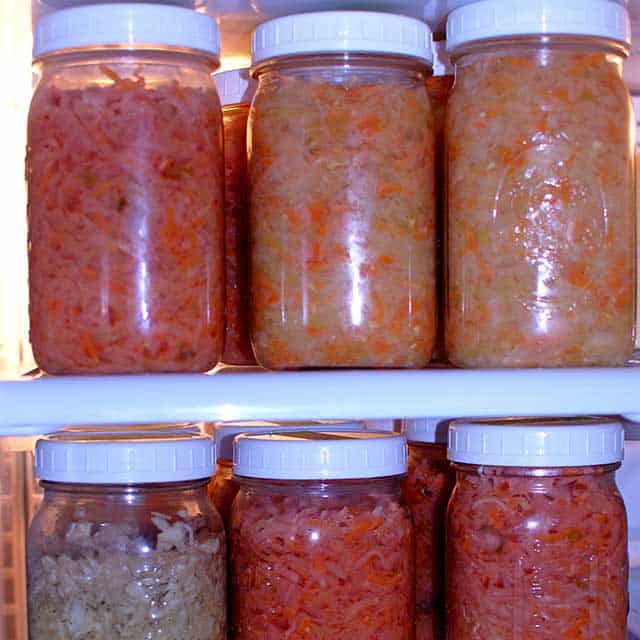
During the months I store my sauerkraut in the fridge ideally, I want everything packed safe and cozy below the brine. This is to prevent air exposure and loss of nutrients. This will be part of my fermentation tests. And, it is a bit of a challenge because sauerkraut contracts in the cold, pulling the brine back into the cabbage.
Ever notice how in that jar of sauerkraut fermenting on the counter, the brine level rises as the house warms and lowers as the house chills? Makes for a pretty cool thermometer.
Review of the ViscoDisc Canning Buddies
Review of: ViscoDisc Canning Buddies (Affiliate Link) by ViscoDisc (Non-Affiliate Link)
Use: With wide-mouth and regular-mouth canning jars. Holds your ferment below the brine. Be sure to purchase the right size. You will also need a one-time purchase of the Inserter which comes as a 2-pack to include both a regular-mouth and wide-mouth Inserter.
Evaluation is with similar products in mind. Upcoming posts will cover the FermentEm Waterless Airlock, SteriLIDS and the Kraut Source Fermentation Lid. A previous post covered the Pickle-Pushing No-Float Jar-Packer and the Pickle Pipe Pickle Pebble [MasonTops] REVIEW: Delightfully Simple.
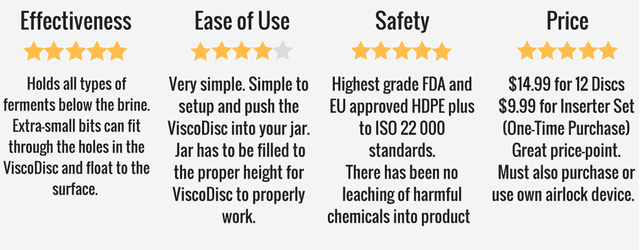
How the ViscoDisc is Designed to Work
Since I often dive right in and intuitively use a “shiny new toy” it can take a while to totally get how it is designed to work. You’ll see my foibles with the various ferments, but for now here’s how the ViscoDisc is designed to work.
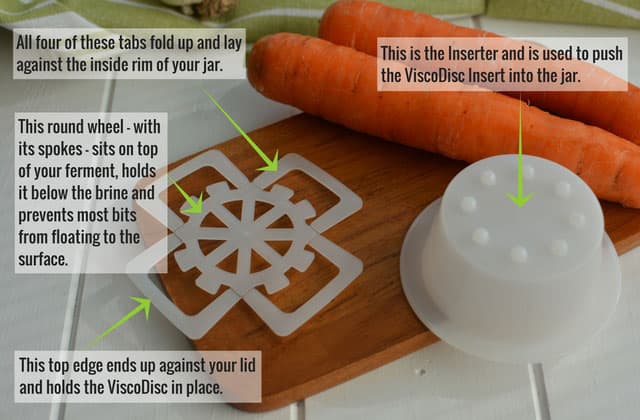
A nifty, inexpensive way to make sure your ferment is below the brine.
Sinking in the brine conquers evil every time.
– Kirsten Shockey, Fermented Vegetables
– Kirsten Shockey, Fermented Vegetables
Product Information
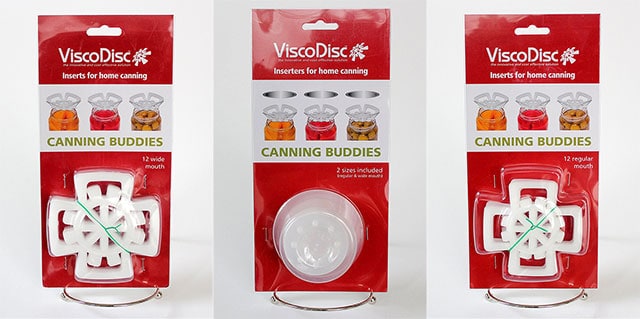
The ViscoDisc Home Starter Kit provides the answer to that age-old larder conundrum – how to keep bottled produce below its preserving liquid (normally brine, vinegar or oil) thus preventing oxidation while retaining freshness and colour.
There are three products in the ViscoDisc line:
- Wide-mouth Canning Buddies.
Each package includes 12 reusable Inserts or “Canning Buddies” for wide-mouth canning jars. Amazon affiliate link. - Regular-mouth Canning Buddies.
Each package includes 12 reusable Inserts or “Canning Buddies” for regular-mouth canning jars. - Inserters.
Each package contains 2 Inserters: Wide-Mouth Inserter, Regular-Mouth Inserter. This device is used to push the Insert down into the jar. A set of bumps on it aligns with the openings in the Insert to hold it in position as it is pushed down into the jar. Amazon affiliate link, - ViscoDisc inserts are manufactured to an ISO 22 000 standard in an ISO 22 000 certified factory. These are food safety management manufacturing guidelines.
- ViscoDisc is a stable FDA approved HDPE (High-density polyethylene)material that hygienically and effectively holds your ferments below the brine. Tests have shown no leaching of harmful chemicals into the product being fermented.
- By keeping everything below the brine, there is no oxidation or loss of nutrients.
- All products are recyclable.
About the ViscoDisc Company
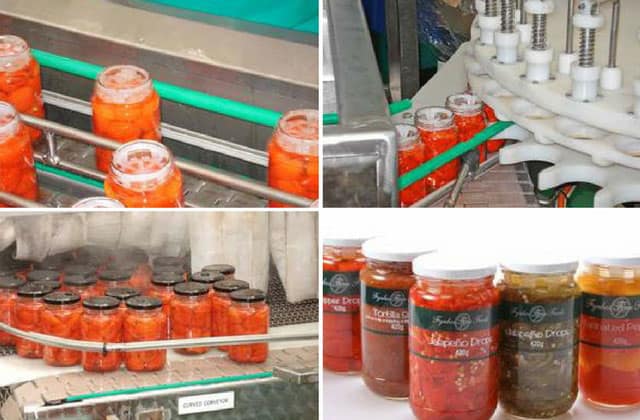
The ViscoDisc is a South African company that has had the Canning Buddies product line on the market for over ten years. They originally introduced the disc as an application for large-scale pickle manufacturers, an industry requiring a necessary shelf life of up to 3 years. They enthusiastically embraced the effectiveness of Canning Buddies.
The ViscoDisc Canning Buddies were so effective at keeping pickles and sauerkraut underneath the brine for the commercial industry, that soon mason jar fermenters flocked to the invention with just as much enthusiasm.
“It was a happy little accident in a way for all of our mason jar fermentation fans, being much more effective, useful, and economical than the alternative glass jar weights you might find out on the market.” – Jon Lusby, ViscoDisc
ViscoDisc’s original commercial customers are still using them to this day. Manufacturers of the ViscoDisc product line recommended the use of HDPE plastic to ensure durability and safety while being placed in acidic solutions with food for long-term storage.
The company recently launched their product in the US and Canada so now their nifty little invention is available to a larger audience.
ViscoDisc Canning Buddies in Action
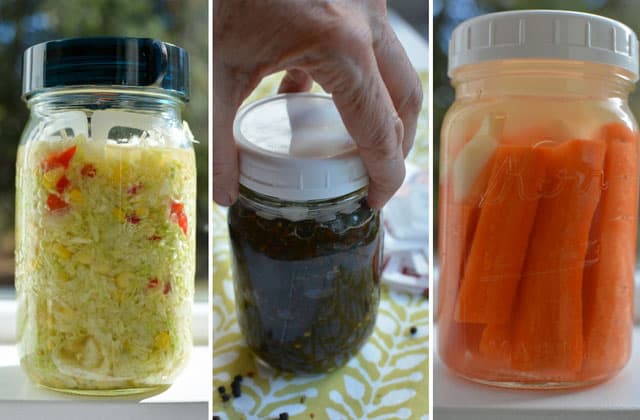
I tested the ViscoDisc Canning Buddies with three types of ferments: sauerkraut, a thick chutney, and carrots in a watery brine.
Sauerkraut
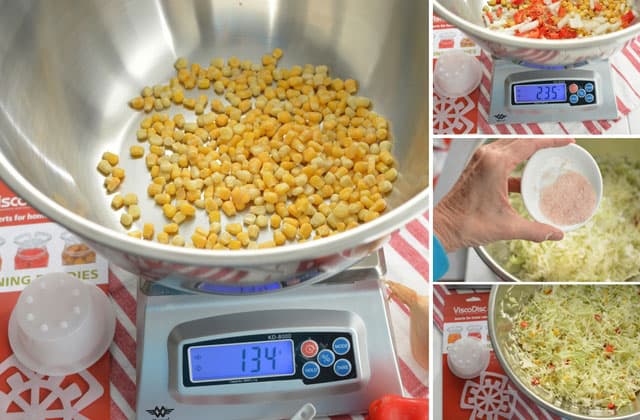
I made up a quick batch of my Corn Relish Sauerkraut using my MyWeigh KD8000 set to grams. Ingredients are weighed, cabbage is added until the scale reads 800 grams and then salt is added. Once it was mixed well and the brine had formed, it was ready to be packed into a jar.
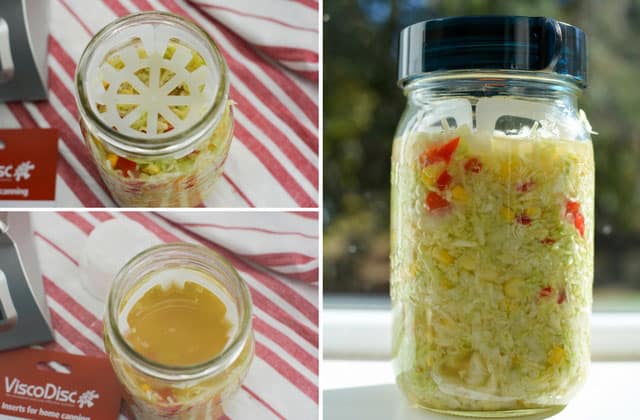
I packed my jar and then inserted the ViscoDisc Canning Buddy. As you can see in the top picture, the level of sauerkraut in my jar was not high enough.
When properly placed, the ViscoDisc tabs fit into the jar rim with the actual disc at the shoulder of the jar as in the top picture. Since my sauerkraut mixture was too low, I improvised and pushed the ViscoDisc down into the jar. The neck of the jar kept the ViscoDisc in place and it remained there for the duration.
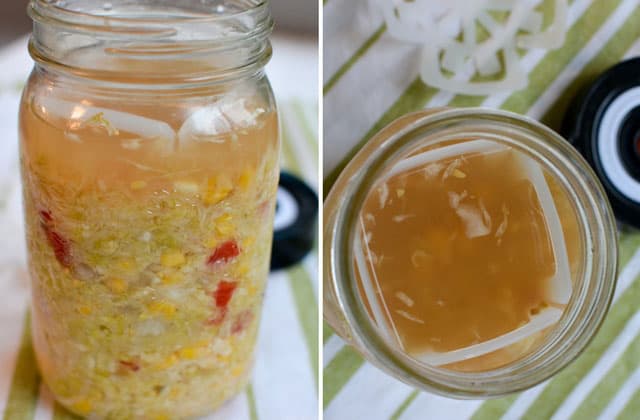
Here is my jar of sauerkraut at the end of its four weeks of fermentation. My sauerkraut mixture remained below the brine, I had no brine overflow and just a few bits floated to the surface.
The size of the openings in the ViscoDisc do allow for small bits of vegetables matter to float to the surface. In this batch, I didn’t use a “floaties trap” to catch those bits – a cabbage leaf torn to size – but would recommend doing so.
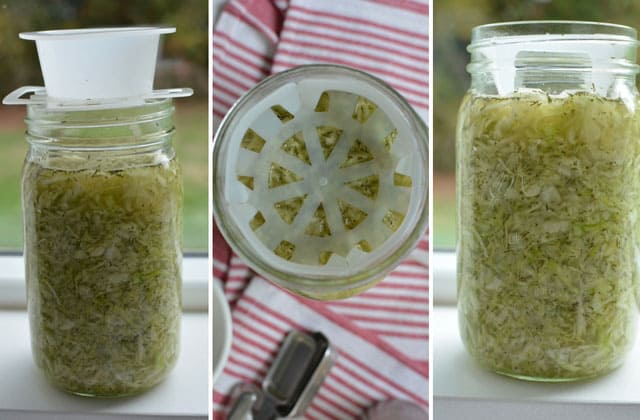
I wanted to figure out how much sauerkraut should be packed into a quart (liter) jar in order to have the mixture at the right level for the ViscoDisc to do its job. In this set of pictures I used my standard 1 ¾ (800) grams. As expected, not quite enough.
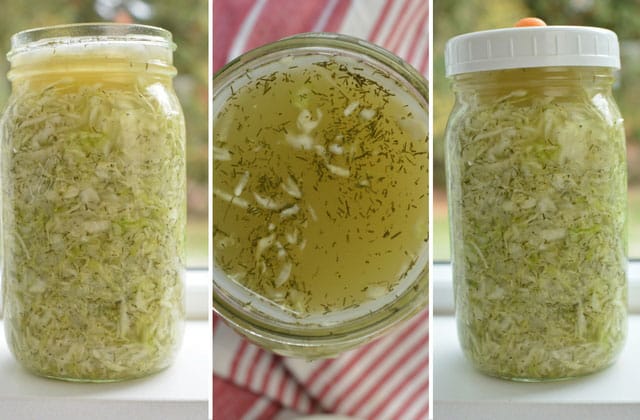
I prepared another 100 grams of salted sauerkraut and added that to the jar to make a total of 900 grams. Perfect! I will now see how 2 pounds (900 grams) of sauerkraut will work in the various batches of sauerkraut I ferment this Fall.
My Discoveries When Fermenting Sauerkraut with the ViscoDisc Canning Buddies
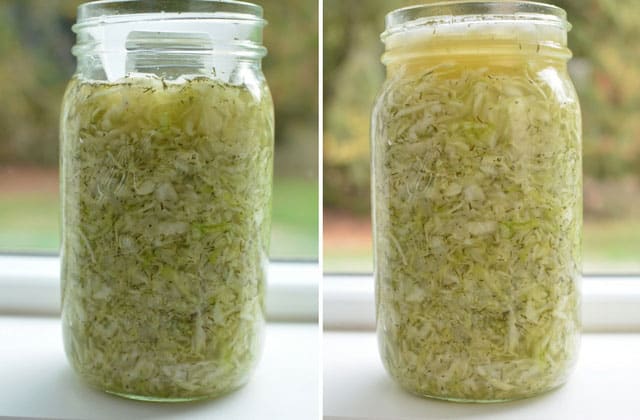
The jar on the left does not have enough cabbage packed into it for the Canning Buddies to hold the mixture below the brine, while the jar on the right is fine. There is some expansion during those first few days, so then it might be O.K.
The Canning Buddies work great IF…
you pack your jar to the right height.
Since my recipes are designed to be weighed out as single-jar batches, I would have to adjust the recipe to have the right amount of mixture for the jar. In addition, the volume of a different varies due to the density of the ingredients used making my method a bit fickle when trying to pack your sauerkraut to a predetermined height.
I’ll experiment more with the Canning Buddies during all my sauerkraut making this fall and let you know how I fine-tune it.
Fermented Carrot Sticks
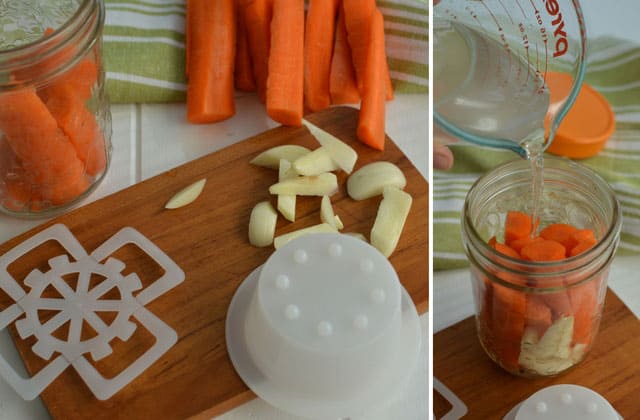
Putting together a batch of fermented carrots sticks is quick and easy. Pack cut carrot sticks, flavoring – slivers of fresh garlic – into jar and pour in brine.
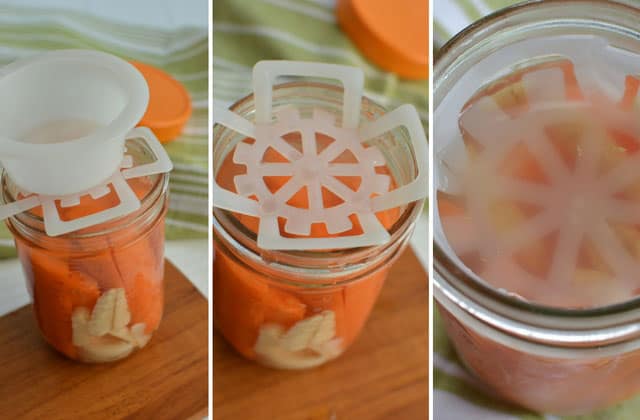
Here the ViscoDisc Canning Buddy is inserted into a wide-mouth pint jar to hold everything below the brine. If you look carefully (in the first two pictures), you’ll see that the disc is too small for the jar opening. I grabbed the one sized for a narrow mouth jar. 😡 Ooops! If you buy both sizes, pay a bit more attention than I did to the ViscoDisc you grab or store them separately.
Even though the ViscoDisc is only intended for use with jars that have a shoulder, the right-sized Canning Buddy did work with the straight-sided wide-mouth pint jar as shown in the picture at the far right. The tabs overlapped a bit, but the Insert stayed in place for the duration.
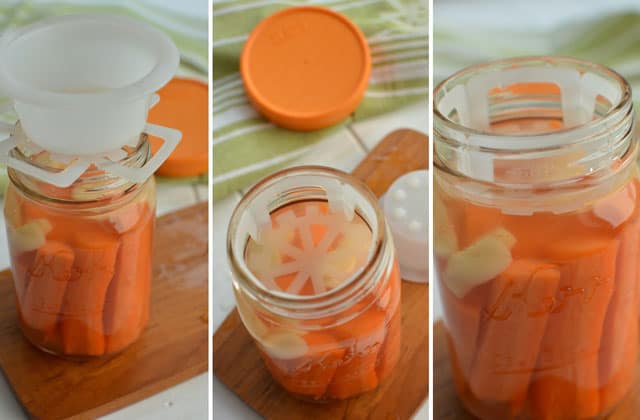
Round 2: I repacked everything into a regular- mouth pint canning jar and used the right sized Insert. 🙂 Now… it works like a charm. In the right two pictures, you can see how nicely the tabs come together and that the carrots are being held below the brine.
My Discoveries When Fermenting Brined Vegetables with the ViscoDisc Canning Buddies
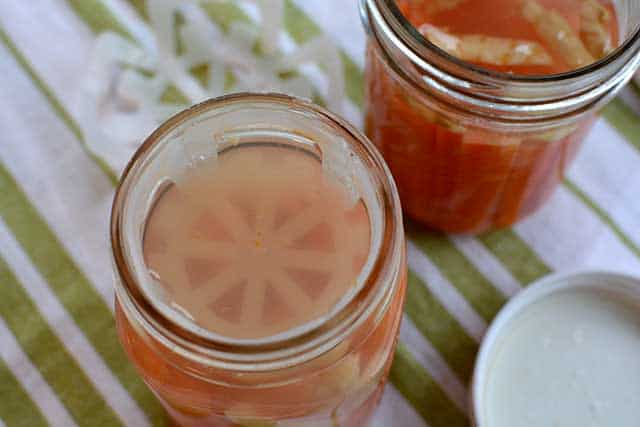
The Canning Buddies are quick and easy and quite effective with brined ferments such as carrots. If you have lots of small bits of seasonings, you might want to use a piece of parchment paper below the ViscoDisc to act as a floaties trap. Or, as one of my readers has suggested: a piece of unbleached cheesecloth or “butter muslin.”
One drawback of using the regular-mouth jars is the lack of airlock systems for them. Not crucial with these shorter ferments, just something to be aware of.
Raisin Chutney
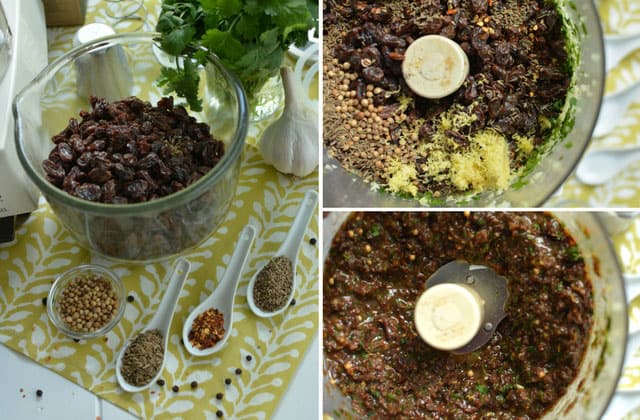
I always want to test a new fermentation product with a relish (like this Cranberry-Orange Relish), paste or chutney to see it it is able to keep the packed mixture in place. Here the ingredients for Fermented Raisin Chutney are pulsed in my food processor.
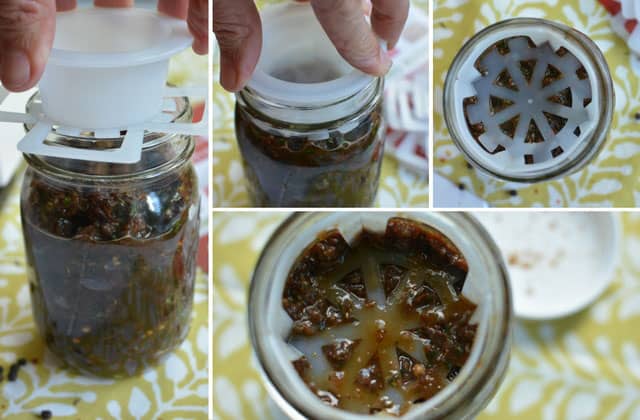
One great thing with the ViscoDisc Canning Buddies is that they are available in two sizes, for regular-mouth jars and wide-mouth jars. Since I like to ferment my relishes in smaller jars, I found it helpful to be able to use one of my regular-mouth pint jars for this chutney. The only hitch was… no lid and airlock device sized for the jar. 😥
In the pictures, you first see the ViscoDisc placed on top of my packed jar. The Inserter for the regular-mouth jar (both sizes are sold together) is used to push the Inserter down into the neck of the jar where it sits in place on top of the packed mixture. I pushed it down a tad bit more to get some of the “brine” to rise to the top.
A few days of fermentation produced a delicious Raisin Chutney that I’ve been eating with pork dishes or grabbing a small spoonful of it when wanting something sweet.
My Discoveries When Fermenting a Relish or Paste with the ViscoDisc Canning Buddies
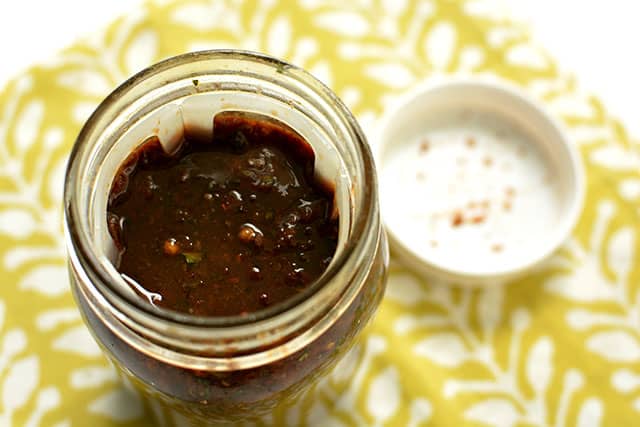
I often ferment relishes, pastes, and chutneys in small batches, so I love that the Canning Buddies are also sized to fit regular-mouth canning jar. As with sauerkraut, the jar does need to be packed to the proper height for the ViscoDisc to work most effectively. In this jar, I was able to push the Canning Buddies down to the right level for fermentation.
One drawback of using the regular-mouth jars is the lack of airlock systems for them. Not crucial with these shorter ferments, just something to be aware of.
Below the Brine During Storage?
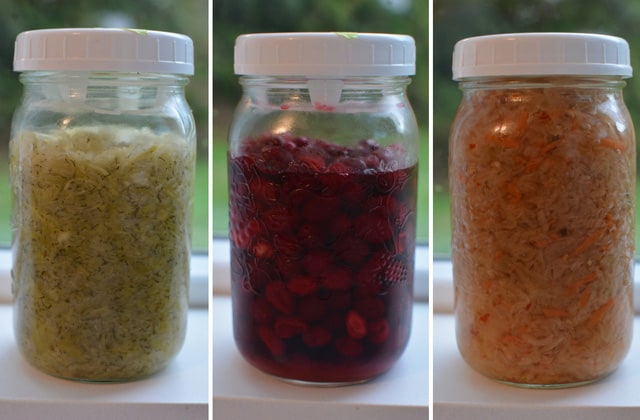
I pulled a few jars from my fridge. The jar on the left had brine all the way to the bottom of the jar threads when I put it into the fridge a few weeks ago. I fermented this jar using the ViscoDisc. Look at how much brine is pulled back into the sauerkraut!
Likewise, the jar in the middle of fermented cranberries had brine coverage above the ViscoDisc. Again, quite a bit of brine was pulled back into the ferment.
The jar on the right looks the best. This jar of Kimchi-Style Sauerkraut was fermented in a crock and then packed into this jar. I pack the jar to the threads and packed about a quarter pound more into the jar than what would normally be fermented in the jar. Nice brine, but still a bit dry at the very top.
I’ve been recommending against adding more brine to a jar because I find it dilutes the flavors I work so hard to create but now I come to the realization that if I want to prevent dry kraut and oxidation, I am just going to have to add more brine.
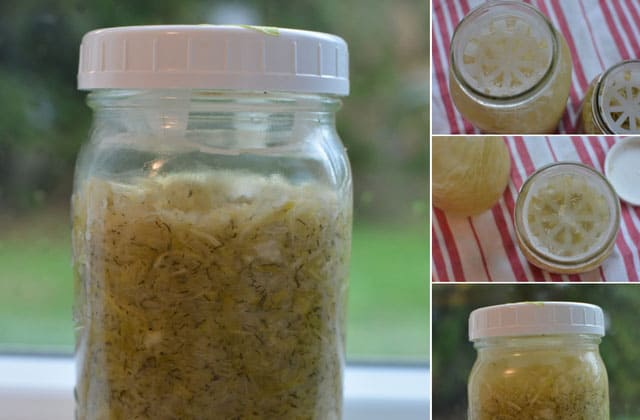
Since I have been experimenting with making Sauerkraut Juice, or “Gut Shots,” I thought that might be an alternative to just mixing up a brine.
The jar on the left is before adding more brine.
That tall jar in the top-right picture is one of my Sauerkraut Juice experiments. Just cabbage and a 2% brine. Theoretically, using this will not shift the flavors as much. I put a ViscoDisc in the jar so it would act as a strainer and hold back loose bits of cabbage as I poured in some brine. The center-right picture shows the jar with brine now to the bottom of the threads. I ended up adding almost ¾ cup of brine to the jar! The bottom-right picture is my jar with plenty of brine.
If you want to add more brine to your sauerkraut either dissolve 1 tablespoon salt in 2 cups of water or wait for my Gut Shot recipe. Or, email me for a few tips to get you started.
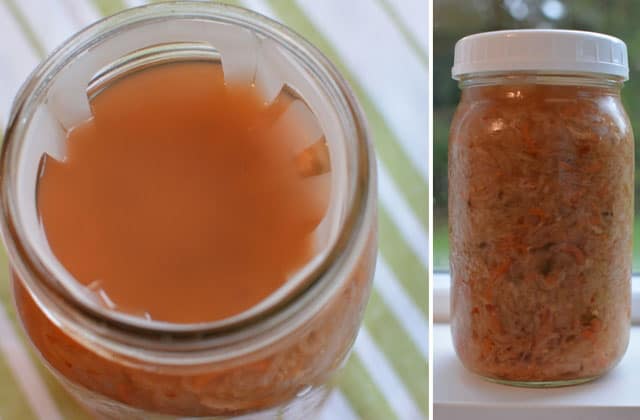
My last jar to fiddle with was the Kimchi-Style Sauerkraut that had been fermented in a crock. Just inserting the ViscoDisc did the trick.
ViscoDisc Canning Buddies Conclusion
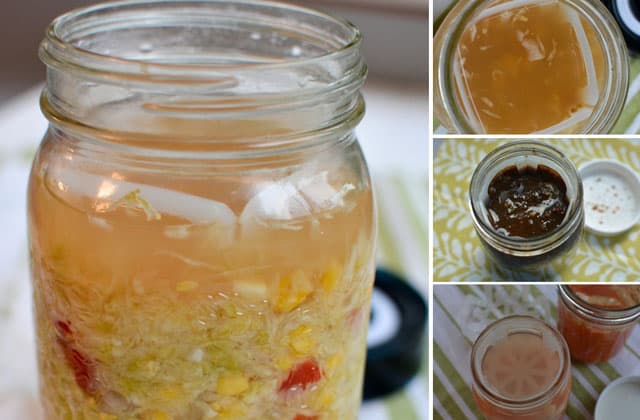
The ViscoDisc Canning Buddies performed beautifully in my test with three ferments: sauerkraut, raisin chutney and fermented carrot sticks.
The ViscoDisc Canning Buddies are ideal for small batch mason jar fermentation. They are simple to use and performed well for the ferments I tested them with. I love that they can be used with a variety of sized jars and styles.
It is recommended that the Canning Buddies be washed in soapy water before use.
When using the ViscoDisc Canning Buddies be sure to pack your jar to the right height in order for the Insert to do its job.
Pros of the ViscoDisc Canning Buddies
- Low profile.
Since they take up such little space in your jar, there is plenty of room for brine expansion and little chance for brine overflow during the initial active stage of fermentation. - Low price point.
The purchase of 12 Pickle Pebbles would set you back over $50; 12 Canning Buddies? $14.99. - Available in two sizes.
Available in sets of 12 for both regular-mouth and wide-mouth canning jars. Be sure to also order – one-time purchase – the Inserters that are used to push the disc down into your jar. - Effectively hold your ferment below the brine.
Key to successful fermentation is keeping your ferment below the brine. The Canning Buddies do a great job of this. - Cost-effective way to hold your ferment below the brine during storage.
Though, as I’ve discovered, you will have to add extra brine to your jar. - Don’t leach chemicals into your ferment.
The plastic used for the Canning Buddies has to withstand the abuse required for commercial canning: hot water bathing (pasteurization of up to 245 F) and storage in containers with vinegar. So when it comes to the salty brine and natural acidity produced from during fermentation – that is just a small about of abuse the disc can withstand in comparison to what pickle manufacturers are doing.
Cons of the ViscoDisc Canning Buddies
- Jar must be packed to a specific height for the ViscoDisc to work most effectively.
Since my recipes are designed to be weighed out as single-jar batches, I would have to adjust the recipe to have the right amount of mixture for the jar. In addition, the volume of a different varies due to the density of the ingredients used making my method a bit fickle when trying to pack your sauerkraut to a predetermined height. - Not designed for use with straight-sided jars.
I used the wide-mouth Canning Buddies for a few ferments in a straight-sided wide-mouth jar. Though not intended for this, the Canning Buddies stayed in place. - Size of holes in the disc may allow small bits to float to the surface.
This is easily taken care of by using some type of floaties trap, such as a cabbage leaf torn to size. - Absorb odors.
As with any plastic or silicone, you may find the discs retain fermentation odors.
Now, one more choice for all us on an effective way to hold a fermenting mixture below the brine. I will most likely make good use of my set of ViscoDisc Canning Buddies to keep my ferments below the brine when storing them. Let me know what you think of them.
Other Fermentation Products to Consider
Here are some reviews I have done on other fermentation products designed for keeping your ferment below the brine:
Pickle-Pushing No-Float Jar-Packer Review: Ingenious
Pickle Pipe Pickle Pebble [MasonTops] REVIEW: Delightfully Simple
If you have used ViscoDisc Canning Buddies – or if you do – feel free to leave a comment and share your thoughts.
Last update on 2024-04-19 / Affiliate links / Images from Amazon Product Advertising API

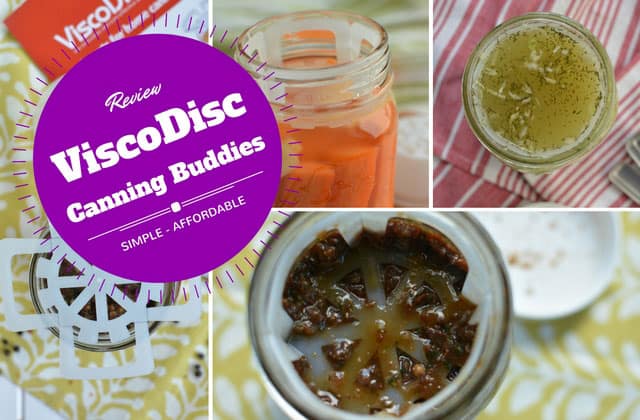

 This post may contain affiliate links which won’t change your price but will share some commission.
This post may contain affiliate links which won’t change your price but will share some commission.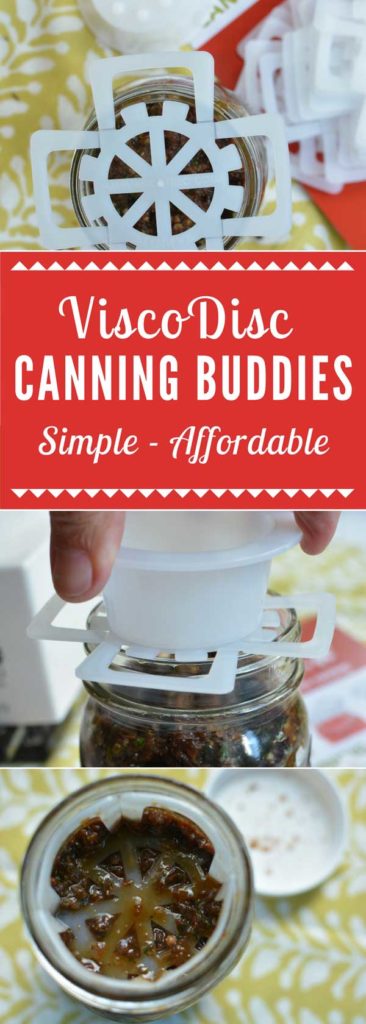



After reading all your reviews I decided to order the canning buddies. I like how they seem to be the simplest method, and I always try to keep it simple! Between my husbands pickles, my pickled beets, and now all these fun ferments we’ve been making, it really made sense to go ahead and get something to keep all our homemade products in prime condition. Thanks for the reviews!
You’re quite welcome. I’d love to hear how they work for you. I’ll be experimenting with my sauerkraut to know just how much to pack in the jar when using the Canning Buddies.
The Buddies arrived and I went about adding them to the “in-progress” qt and 1/2 gal ‘krauts, as well as the pickled beets & pickles (1/2 already in the fridge. As you warned, smaller quantities didn’t allow them to work as designed, but I just pushed them down in the jar. It still worked to keep below the brine. And now my beets and pickles won’t dry out while in the fridge. Thanks for the review.
Hello Bethann, Yaa! New fermentation toys. Yes, I also just pushed a few of mine down into the jar and haven’t had them move on me. Will see how they make it through this year’s sauerkraut batches.
I just found your site and decided to check out the Canning Buddies on Amazon. When I click your affiliate links on this page, I see $68.14 for the Canning Buddies and $48.77 for the inserters. I don’t often shop at Amazon, so I don’t know if it is normal for them to charge different prices for the same item or if it is some kind of fluke, but that is way out of line. These are the pages that come up:
https://www.amazon.ca/s/?field-keywords=ViscoDisc%20Canning%20Buddies-%20Wide%20Mouth%20Mason%20Jar%20Canning%20Inserts%2C%2012pk-%20Helps%20Keep%20Your%20Pickled%20Fruits%20and%20Veggies%20Submerged%20Under%20the%20Brine%21&tag=makes0d-20 – for the inserts and
https://www.amazon.ca/s/?field-keywords=ViscoDisc%20Canning%20Buddies-%20Wide%20%26%20Regular%20Mouth%20Mason%20Jar%20Canning%20Inserter-%20Helps%20Insert%20Your%20Discs%20to%20Keep%20Your%20Pickled%20Fruits%20and%20Veggies%20Submerged%20Under%20the%20Brine%21&tag=makes0d-20 – for the inserters.
Hello Deborah, Not exactly affordable prices!
Those are absurd price changes for the Amazon.ca website. The prices I mentioned are via the Amazon.com website. I live in Canada and deal with similar frustrations. Sorry for the frustration.
I would consider the Pickle Pusher with/without the airlocks (shipping to Canada should be reasonable) and the Pickle Pipes for airlocks (available on Walmart.ca) until Canning Buddies are truly available in Canada. I”ll contact the owner to see what their plans are. Best of luck.
https://www.makesauerkraut.com/pickle-pushing-no-float-jar-packer-review/
https://www.makesauerkraut.com/pickle-pipe-pebbles-review/
Hi Holly. Thanks for the help. Amazon is weird. First of all, I am in the U.S., so I don’t know why the links sent me to amazon.ca rather than amazon.com. Since I am not too far south of the border, I am wondering if my request was routed through Canada, so that is where Amazon thought I was. When I tried the link for Pickle Pipes, they listed a regular price of $99.95 for four, on sale for $54.95—not much better. I don’t have much tolerance for companies that change their prices that much based on where they think you live or some other arbitrary criteria.
I am not in a particular hurry to buy any of these, but am thinking ahead for the warmer weather, so I can afford to look around a bit. There is a Walmart store within a reasonable driving distance from me, so I might check with them. Sometimes they have the option to order items online that they don’t normally stock and have them delivered to the local store for pickup. Thanks again!
Here is an update. Walmart.ca may have Pickle Pipes, but apparently they are not available in the U.S. even for ordering online. I did some searching and ended up on the manufacturer’s website, masontops.com. They had a package of twelve listed for $53.95, with free shipping and a promotional 12% discount. I ended up ordering twelve Pickle Pipes, twelve Pickle Pebbles, and the wooden vegetable packer for under $100.00. It will be a big improvement over my current setup of washed rocks sealed in plastic bags sitting on top of whatever I can find to keep them level. I actually prefer glass to plastic anyway, because I have very hard water and no dishwasher, so plastic is harder to clean. I am looking forward to trying them.
Happy to hear you’re hard shopping work paid off. It’s amazing how much prices can vary. It sure is nice to have a few good tools. Enjoy fermenting with them.
For future reference, the owner from ViscoDisc let me know that they also sell their Canning Buddies through http://shop.reusablecanninglids.com/main.sc. This company might have reasonable shipping rates to Canada. The Amazon.ca seller is not associated with ViscoDisc.
That is great to know. I actually discovered reusablecanninglids.com a couple of years ago and bought lids and rings from them before they started carrying Canning Buddies. I never thought to look there. They have a dozen regular mouth ViscoDiscs listed for $8.50, and wide mouth for $10.40, and free shipping in the U.S. for orders over $50.00, and good products and service. It doesn’t take much for me to put together a fifty dollar order. Thanks!
Yes, I’ve also used the reusable canning lids. They work great. Glad we found you a better source for the ViscoDiscs.
Hey thanks for the info!! Is there someplace where you posted your single jar ingredients measurements at?
That would be on any of my sauerkraut recipe posts: https://www.makesauerkraut.com/sauerkraut-recipes/ If you are using the Canning Buddies, up the ingredients to 900 grams and then 14-18 grams salt.
Do you know if these can be used to hold peppers down when canning. Are they safe to be boiled and then stay in a jar for a year??
YES! That’s what they were first approved for and are how they are generally used. Fermentation use was their secondary use.